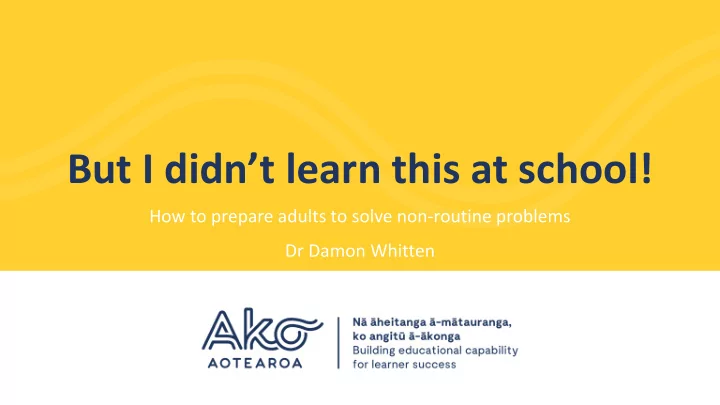

But I didn’t learn this at school! How to prepare adults to solve non-routine problems Dr Damon Whitten
Paralysis when faced with complex non-routine problems “But I didn’t learn this in school” Whitten, 2018
ALN Effective Practice Model
The defining characteristic of future workplaces is … Change
How do we use literacy and numeracy to prepare adults for a world of constant change?
What skills are needed in the modern environment? • Improvisation • Adaptability • Innovation • Creative Being able to deal with thinking novel problems and situations
Grande the chimpanzee builds a three-box structure to reach a banana. (Kohler, 1927)
Brutus the alpha male used a ‘symbolic drumming code’ to coordinate an 80- chimpanzee troop. Tai National Park (Boesch, 1996)
But how smart are we humans?
Human ingenuity: Escape from Stalag Luft III • Three tunnels created in ‘impossible tunnel conditions’ • The tunnels had electrical lighting, air pumps, rope operated trolley systems and workshops • 100 tons of soil excavated
Human ingenuity: Escape from Stalag Luft III Materials used in construction: • 4000 bed boards • 52 twenty-man tables • 34 chairs • 635 mattresses • 1400 milk cans stolen and used as digging tools
Then why do we not always see human improvisation, innovation and creativity?
There are some predictable challenges that humans have when it comes to innovation and creativity.
Hint, the challenges are mostly due to being too ‘fixed’ in our thinking.
Functional fixedness How do you tie the two strings together if you cannot reach them both at the same time?
Functional fixedness Can you use these items to mount the candle on the wall so that it can be lit in the normal way without it toppling over?
Functional fixedness Can you use these items to mount the candle on the wall so that it can be lit in the normal way without it toppling over?
Mental sets Connect the nine dots with four interconnected straight lines without lifting your pencil from the page as you draw.
Mental sets Connect the nine dots with four interconnected straight lines without lifting your pencil from the page as you draw.
Can we unteach adaptability, innovation, and creativity?
The Alternative Use Test A divergent thinking test and exercise. Guilford, 1967
The Alternative Use Test Take 30 seconds to think about as many uses for a paperclip as possible.
The Alternative Use Test I was shocked to learn that results decrease as the participants age! Adults have a tendency to become entrenched in routine ways of thinking.
What about school mathematics? Can learning maths stifle improvisation, innovation and creativity?
The Pesek and Kirshner studies Method Two groups Group 1 received five days of instrumental instruction on finding the area and perimeter of squares, rectangles and triangles. Pesek & Kirshner, 2000
Method Rectangles Two groups Perimeter = 2(L + Height H) Group 1 received five days of instrumental instruction Area = L x H on finding the area and perimeter of squares, Length rectangles and triangles Group 2 got to go and play! Pesek & Kirshner, 2000
Method After this both groups were combined into three days of relational instruction • Connection finding • Concrete materials • Discussions • Problem solving Pesek & Kirshner, 2000
Post test results Group 1 scored 14.36 and demonstrated almost no transfer to new problems Group 2 scored 16.42 score showed excellent transfer to new problems Conclusion Instrumental mathematics interfered with learners’ ability to learn, improvise and innovate. Pesek & Kirshner, 2000
Schoenfeld, A. (2011). How we think. New York, NY: Routledge.
“But I didn’t learn this in school” Whitten, 2018
So what do we do to develop improvisation, innovation, adaptability and creative thinking within the context of numeracy?
One way is to develop learners’ use of heuristic approaches. Heuristics “Knowing what to do when you don’t know what to do” Gary Kasparov
1. Engage learners in unknown and novel problems that they do not know how to solve 2. Provide them with a heuristic method they can use to investigate, interrogate, and solve the problem
Phases of engagement What to do 1. Work to understand the problem when you don’t 2. Make a plan know what to do 3. Carry out the plan 4. Look back
Work to understand the problem What do we know? 1. What don’t we know? 2. Restate the problem in your own words 3. Draw a picture - fill in details 4. Do you understand all the words? What are 5. you asked to find or show?
Make a plan • Have you seen anything like this before? • How did you solve that problem? • Invent a similar but solvable problem – compare and contrast • Could you solve part of the problem? • Make a plan
Strategies that learners can use in the planning stage Guess and check Eliminate possibilities Look for a pattern Solve a simpler problem Make an orderly list Use a model Draw a picture Use direct reasoning Work backwards Use a formula Be ingenious
Carry out the plan • Carry out the plan and check each step • Can you see clearly that the step is correct? • Have you seen anything like this before?
Looking back (check, check, check!) • Can you check the result? • Can you check the argument? • Can you use this approach to solve another problem?
ALN Effective Practice Model Heuristic problem-solving approaches will be integrated into numeracy professional development next year
For more information on any of the information seen here please go to: https://ako.ac.nz/ For a full schedule of professional learning options please go to: https://ako.ac.nz/professional-learning/alnacc/
Recommend
More recommend